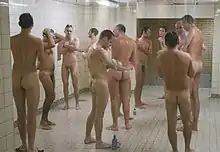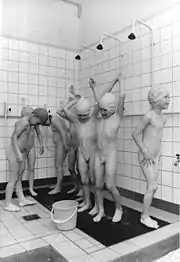Communal shower
Communal showers are a group of single showers put together in one room or area. They are often used in changerooms, schools, prisons, and barracks for personal hygiene. Although the use of communal showers has grown less prevalent in the West in the 21st century than they were in prior years, they are often present in school locker rooms for use in personal hygiene after physical education. They also continue to exist in some gymnasia and at many swimming pools.



History
Modern communal showers were installed in the barracks of the French Army in the 1870s as an economic hygiene measure under the guidance of François Merry Delabost, a French doctor and inventor. As surgeon-general at Bonne Nouvelle prison in Rouen, Delabost had previously replaced individual baths with mandatory communal showers for use by prisoners, arguing that they were more economical and hygienic.[1] The French system of communal showers was adopted by other armies (the first being that of Prussia in 1879) and by prisons in other jurisdictions. They were also adopted by boarding schools, before being installed in public bathhouses. The first shower in a public bathhouse was opened in 1887 in Vienna, Austria. In France, public bathhouses and showers were established by Charles Cazalet, first in Bordeaux in 1893 and then in Paris in 1899. They quickly proved successful, with the latter only closing in 1985.[2]
Current status
In the United States and in some English-speaking provinces of Canada, students at public schools have historically been required to shower communally with classmates of the same sex after physical education classes. In the U.S., public objections and the threat of lawsuits have led a number of school districts to make showers optional or to abolish the practice entirely. Private boarding schools and military academies in the U.S. often have communal showers, since the focus there is on 24-hours-a-day education and rooming, rather than just acting as day schools.[3]
In many parts of the western world, the number of schools with open communal showers has gradually decreased and has been replaced with individual and private spaces for bathing due to students' religious and privacy concerns.[4][5][6]
A court case in Colorado noted that students have a reduced expectation of personal privacy in regards to "communal undress" while showering after physical education classes.[7] According to an interview with a middle school principal, most objections to showering at school that he had heard were actually from the students' parents rather than from the students.[8]
See also
References
- Dajon, Hervé (26 January 2013). "La douche, une invention d'un médecin des prisons, le docteur Merry Delabost" [The Shower, a medical invention for prisons by Dr Merry Delabost]. Varia (in French). Criminocorpus [En ligne]. Retrieved 2018-08-06.
- Feltgen, Dr. (18 July 2005). "Dr. Merry Delabost, inventor of the shower?" (PDF). Hopitaux de Rouen. Archived from the original (PDF) on 2012-01-12. Retrieved 2012-09-30.
- ACLU of Washington. "ACLU-WA's Work for Student Rights". Archived from the original on 3 April 2007. Retrieved 28 April 2007.
- Rink, Matthew. "Mandatory showers policy at public schools no longer the rule". The Independent.
- Chua, J. Y. (June 2, 2017). "School Bathrooms Have Always Stoked Controversy". The Atlantic.
- Smithers, Rebecca; Correspondent, Education (December 21, 1999). "Curtains for schools' communal showers" – via www.theguardian.com.
- "Trinidad School District No. 1 v. Carlos R. Lopez". Archived from the original on 27 September 2007. Retrieved 28 April 2007.
- "Interview with John Pleacher 2/16/87". Archived from the original on March 17, 2005. Retrieved 28 April 2007.
